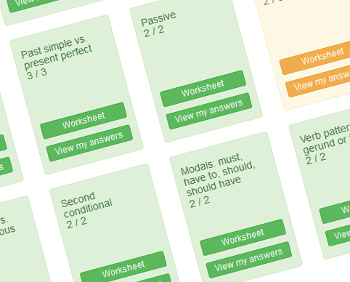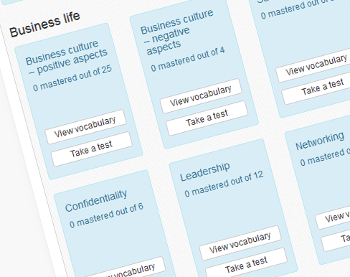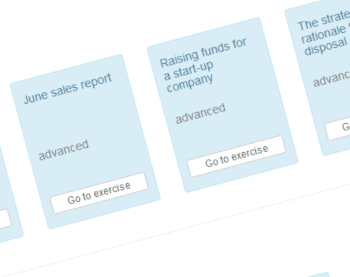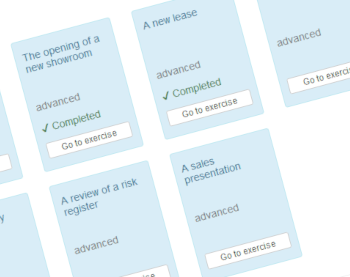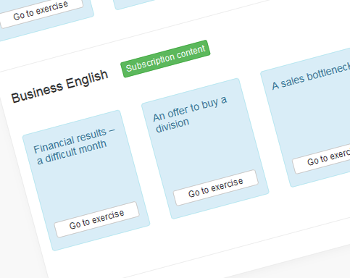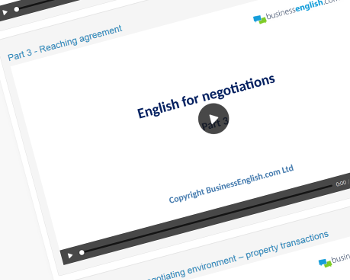Sequence adverbs
(Sequence adverbs)
Introducción
Los adverbios de orden "first", "next", "then" y "finally" se utilizan para describir el orden en el cual suceden dos o más acciones.Ejemplo:
- Cómo hacer una tortilla
"First, I break the eggs. Then, I heat the butter in a pan. Next, I add the eggs. Finally, I eat the omelette with toast."
Forma
Se usa una coma después de "first", "next", "then" y "finally" cuando introducen la frase que describe la acción.-
"first": para una acción que ocurre antes que otras. También podemos usar "first" al final de la frase.
- "I have a lot of work to do. First, I will make a cup of tea."
- "I will make a cup of tea first."
- "next" y "then" pueden usarse tanto para una acción que sucede después de otra acción, pero normalmente se usa:
- "next": para una acción que ocurre inmediatamente después de otra acción, o tan pronto como sea posible. También se puede usar " next " al final de la frase.
- "I went to Bolivia on holiday. "Next", I want to go to Brazil."
- "I’m eating breakfast now. I will clean the kitchen "next"."
- "then": para una acción que ocurre después de otra acción si no es inmediata. Se puede usar "and then" sin coma.
- "Sarah is doing her degree. Then, she wants to be a lawyer."
Sarah will probably not be a lawyer immediately after she gets her degree. - "They went shopping in the morning and then they went to the zoo."
We don’t know if they went to the zoo immediately after they went shopping.
- "Sarah is doing her degree. Then, she wants to be a lawyer."
- "next": para una acción que ocurre inmediatamente después de otra acción, o tan pronto como sea posible. También se puede usar " next " al final de la frase.
- "finally": para la acción que ocurre al final, después de otras, o después de un largo tiempo. Se puede usar "finally" antes del verbo sin una coma.
- "I worked all evening. Finally, I went to bed at 11pm."
- "I worked all evening and I finally went to bed at 11pm."
- "After five years, I finally sold the house."
Más práctica
Complete las frases con la respuesta correcta de a, b, c ó d:.
Create a free Getting Started account
Enlaces relacionados
En los siguientes ejercicios figura el uso de esta estructura gramatical:
También podría interesarle:
- Ejercicios de vocabulario de inglés de negocios
- Escucha Cuenta Pro
- Lectura Cuenta Pro
- Scenario-based dictation exercises – business English Cuenta Pro
- Scenario-based dictation exercises – general English
También podría interesarle:
Principiantes
- Pasado simple
- Pasado continuo
- Presente simple
- Presente continuo (presente)
- El presente perfecto
- Los dos futuros “going to” y “will”
- Presente continuo (futuro)
- El imperativo
- Ser o estar “to be”
- Pronombres: sujeto, objeto
- Pronombres: relativos
- Adjetivos y pronombres posesivos
- Adjetivos y pronombres demostrativos
- Lugar básico de los adjetivos
- Preguntas que empiezan con WH (pronombres interrogativos)
- Los artículos: “a, an, the”
- Las preposiciones de tiempo y lugar
- “There is"/"there are” y los cuantificadores
- Las conjunciones “and","or", "but”
- Los comparativos/superlativos (than)
- El condicional cero “if”
- Primer condicional (if)
- Los verbos modales: “can" / "can´t", "could", "will", "shall”
- Patrones de verbos
- Sequence adverbs
Intermedio
- El pasado perfecto
- El pasado simple vs presente perfecto
- El pasado simple vs pasado continuo
- El presente perfecto continuo
- El futuro simple
- El futuro continuo
- La voz pasiva
- El estilo indirecto
- “Used to" / "would”
- El segundo conditional
- El tercer condicional
- Las oraciones de relativo
- Los pronombres reflexivos
- Los verbos modales: must, have to, should, should have
- Patrones verbales: gerundio o infinitivo
- Los adverbios de grado
- El orden de los adjetivos
- Adjetivos acabados en “ed” o “ing”
Gramática
Identifique rápidamente y concéntrese en los problemas de gramática:
- Hojas de actividades y examen de gramática
- Scenario-based grammar exercises
- Grammar additional practice questions
- Práctica de conjugación verbal
- Práctica de los condicionales
Mejore su gramática
Vocabulario
Vocabulary exercises:Amplíe su vocabulario utilizando nuestros tres profesores de vocabulario:
- Práctica de vocabulario de inglés general
- Práctica de vocabulario de inglés de negocios
- Práctica de giros idiomáticos
Aprenda vocabulario
Ejercicios de dictado
Practique sus habilidades de escucha y escritura utilizando nuestros ejercicios de dictado:
- Scenario-based dictation exercises - general English
- Scenario-based dictation exercises - business English
- Dictado: profundizando en la gramática
- Números
Complete los ejercicios de dictado
Lecciones en video
Concéntrese en áreas concretas dentro del inglés de negocios utilizando nuestras lecciones en video:
Reciba una lección por vídeo
